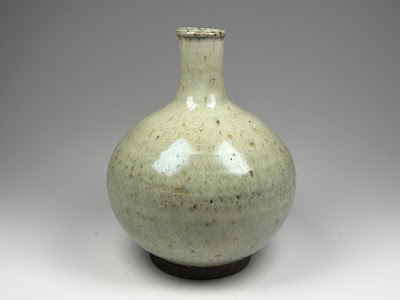岩手と秋田の旅の戦果 Results of a Trip to Iwate and Akita
1 鍛冶町焼の小徳利 Small Kajicho Bottle
岩手と秋田をめぐる旅の途中で手に入れたものをいくつか紹介する。ひとつめは盛岡市内の古物店で手に入れた鍛冶町(かじちょう)焼のちいさな徳利。たっぷりかかった白釉は会津本郷焼に似た感じがする。褐色の胎土はよく焼きしまっている。厚手で手取りは重いが、その割に高台は薄く造っている。臭いからして油入れだったかもしれない。
The items in this page are some of what I obtained in a trip to Iwate and Akita prefectures. The first one is a small bottle which I found at a shop in Morioka City, and is thought to be baked in Kajicho, Hanamaki. I think the white glaze is similar to what is seen in Aizu-Hongo wares. The brown clay is firmly baked. The body is heavier than it looks, but the bottom rim is thin. It might be used as an oil bottle.
江戸時代も後期(19世紀前半)になると東北各地に陶磁器の産地が次々と誕生したが、鍛冶町焼もそのひとつ。窯はいまの岩手県花巻市鍛治町(かじまち)にあり、本家は明治末頃、分家は昭和初頭頃までつづいた。鍛冶丁焼の表記もある。こういった白釉の他、図録を見ると、照りのある黒釉や飴釉、青白いなまこ釉などさまざまな釉薬がみられる(「日本やきもの集成1」平凡社、1987年)。
The Kajicho pottery began in the early 19th century, as did many other Tohoku potteries, and the main potter continued business until the end of Meiji period, and the other until the beginning of Showa period. They used various glazes such as white, black, brown, and bluish white glazes.
2 花巻人形 桃抱き童子 Hanamaki Doll
子どもが大きな桃に抱きついている。誇らしい表情だ。赤い桃にはなぜか花文様が描かれているが、この五弁の花(桜とされる)とその周りの葉脈がくっきり描かれた葉っぱは、花巻人形に独特のもので、トレードマークのようなものである。東北三大土人形のひとつに数えられる花巻人形は江戸後期からつづく歴史あるものだが、この人形は顔料などからして明治期のものだろう。前の徳利とおなじ店で求めた。
A boy smiling proudly is holding a big red peach, on which several flower marks and leaves with veins are drawn as a kind of a trademark of one of three major clay dolls in the Tohoku area, the Hanamaki doll. It possesses a long history since the late Edo period, but I guess this boy was born in Meiji period, judging from the pigments. It was sold at the same shop as the above bottle.
3 白岩焼のすず Shiraiwa Bottle
ちょうど一升はいるすず(徳利)で、貫入のはいった白釉の上にラフなタッチで黒釉をながしかけて景色をつくっている。一見すると会津本郷焼か大堀相馬焼のようだが、胴の下3分の1にみえている赤釉の色や質感はまごうことなく秋田のやきものの特徴を示している。手に持つとかなり重く、首もちょっとかしげていて、会津や相馬ほどの洗練さはない。しかし器全体ににじみ出ている素朴さは、北東北の産地ならではと言えるだろう。
A 1.8 litter bottle with a white glaze that is full of cracks and a naturally drawn pattern of something. It looks similar to Aizu-Hongo or Obori-Soma bottles, but the red brown glaze on the lower part distinctly shows that it was produced in Akita. It weighs more than it looks, and the shape is not smooth. Though the potter's technique might not be so sophisticated, this is an honest craft product born in the northern Tohoku region.
秋田市内の古物店で手に入れた。店主は秋田のやきものに詳しく、本も出版されている(庄内昭男「秋田ふるさとやきもの好」2006年)。この徳利もまず白岩と考えていいだろうとのことだった。いろいろ秋田の古いやきものについて教えてくれて、たいへん有意義な訪問だった。
It was sold at an antique shop in Akita City. The owner knew ceramic wares in Akita very much, and published a book. He said this bottle would be a Shiraiwa ware. It was very kind of him to tell me much about Shiraiwa and other old potteries.
4 白岩焼の輪花形小鉢 Small Shiraiwa Bowl
これもおなじ店で手に入れた皿、というよりはやや深さがある小鉢で、白岩焼でよくみられる青白いなまこ釉と赤釉とを掛け分けている。縁が薄く造ってあって、花びらのように波打たせているのがおもしろい。渡辺為吉「白岩瀬戸山」(1933年)に同様の皿が白黒写真で掲載されており、その類似品と考えられる。おそらく京焼とか有田焼に似た皿があってそれを真似たものだろうが、生活雑器を主に生産した白岩でこういう細工をほどこすのはめずらしいとおもう。
This small bowl, sold at the same shop as above, is decorated with bluish white and red brown glazes, as is common in Shiraiwa wares. The rim is shaped into flower petals, which is probably rare in the Shiraiwa pottery where the main products were low-price daily-use ceramic wares. Similar examples can be found in a book, Shiraiwa Seto-Yama, written by Watanabe Tamekichi in 1933.
5 廣田誉宗 ガラス猪口 Hirota Takamune's Glass Cup
こちらは現代の工芸品。秋田市新屋ガラス工房のショップで求めた。作者の廣田誉宗氏はこの工房内で作品をつくっている作家さんで、お会いはしなかったが、自衛隊に勤務して南極にもいったことがあるという異色の経歴の持ち主らしく、興味深かった。もちろん作品も魅力的で、全体のバランス、使い勝手のよさ、かわいい雪の結晶の文様が気に入った。
This is a modern glassware that I obtained at Akita Araya Glass Studio. Hirota Takamune, a glassware creator at this studio, was once in the Army and had been to Antarctica. I sellected this cup out of many glasswares because of its balance, sense of use, and charming snow symbols.










